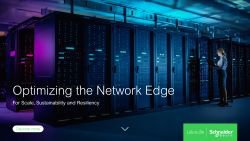Driven by technologies such as IoT, artificial intelligence, AR/VR, Industry 4.0, streaming services, and 5G, the global Edge data center market, valued at $8.27B in 2022, is forecasted to grow at 18 percent a year through 2030.
To meet this market demand, key players at the network Edge ‒ the traditional telecom providers, cloud service providers, and data center colocation providers ‒ face three major challenges when building an Edge data center ecosystem.
Challenge #1: Creating a multi-access Edge framework
The future lies in network Edge data centers that combine traditional telco capabilities (networking and controls) with conventional data center functionality (compute and storage) in regional, local, and multi-access Edge computing (MEC) data centers.
This approach will require telco providers to retrofit their legacy infrastructure from proprietary hardware to systems based on standard IT server hardware and software based on open standards.
It will also require solid relationships, alliances, and partnerships among telcos, colocation providers, and hyperscalers to clarify who builds, owns, and manages these converged Edge data centers for this new complex ecosystem.
Challenge #2: Meeting the unique requirements of Edge data centers
By their very nature, network Edge data centers exist outside of the safe, secure confines of a traditional enterprise data center, hyperscale cloud data center, or regional main colocation facilities.
Edge data centers need to live where the data lives. That means they need to be located close to factories, within smart city infrastructure, near telco cell towers, and they need to be fully managed by service providers.
In the near future, network Edge data centers will be responsible for processing data associated with autonomous vehicles, so they will need to be distributed in a mesh configuration that covers the far-flung highway system.
Network Edge data centers will require remote monitoring and troubleshooting to support mission-critical applications without outages or service interruptions because they typically won’t have on-site IT staff. These data centers also need higher rack densities, which might require liquid cooling. In addition, they will require enhanced levels of security for access control and cybersecurity.
Challenge #3: Minimizing environmental impacts
Sustainability is a broad term that can encompass a variety of metrics, including reducing energy use and water consumption, cutting greenhouse gas emissions, and properly disposing of waste. Sustainability can also extend to sourcing of materials, efficient operations, and even issues such as land management and biodiversity.
It might be easy to overlook the environmental impact of distributed Edge data centers due to their reduced size. But with increasing emphasis on sustainability from regulators, shareholders, and customers, distributed local Edge data center owners and operators need to report the environmental impacts of Edge locations.
The main challenge with reporting on large numbers of distributed network Edge data centers is that they’re installed in a wide variety of locations and environments. In addition, organizations need to choose the right metrics, frameworks, and standards as guidance for environmental impact reporting.
Schneider Electric has developed a TradeOff tool, ‘Data center and Edge global energy forecast’, to help the data center industry estimate energy consumption.
Access the network Edge eGuide for solutions
The challenges of building out and managing network Edge data centers can be addressed with the right approach and resources. To learn more, access the eGuide on network edge data centers, ‘Optimizing the network Edge — For scale, sustainability and resiliency.’
In the eGuide, you will learn how to address sustainability challenges with recommendations on monitoring, how to choose energy efficient IT infrastructure solutions, and how to tap into an ecosystem of partners. These approaches not only improve sustainability but also optimize performance and resiliency at the network Edge.
More from Schneider Electric
-

Sponsored The road to net zero: Where do colocation providers stand?
Sustainability study from Forrester and Schneider tells us more
-

Sponsored What are network Edge data centers?
Why we need them, what they are, and where the Edge is headed
-

Sponsored Building the Metaverse
How a change in mindset could help change the industry and open up a whole new world


